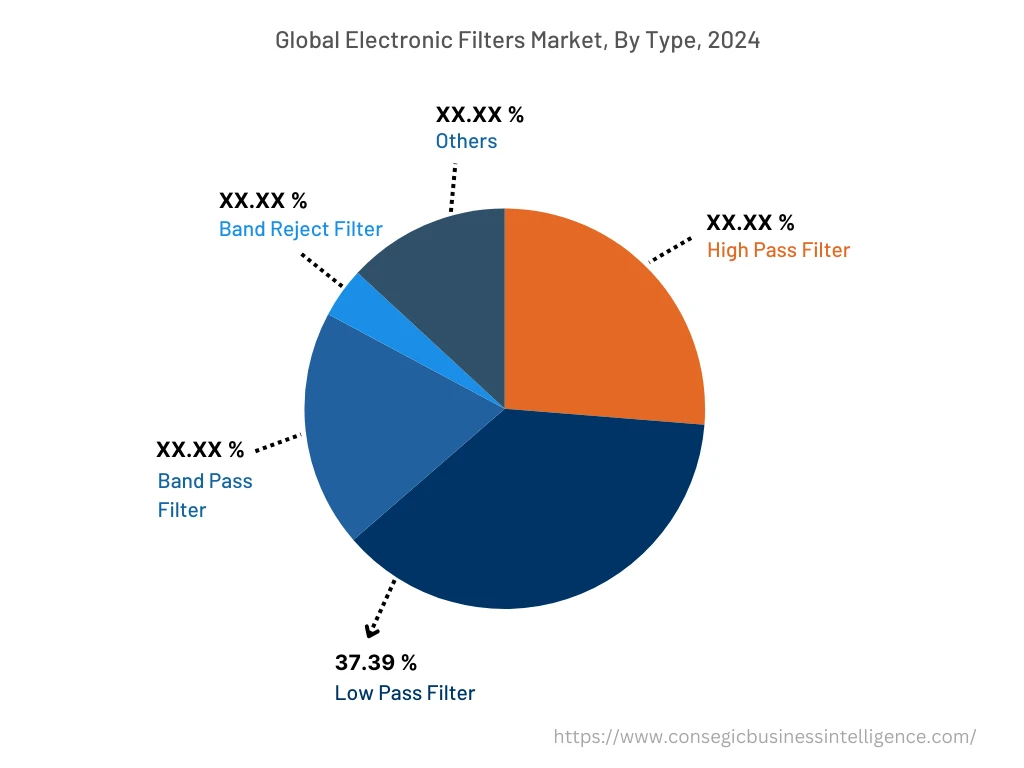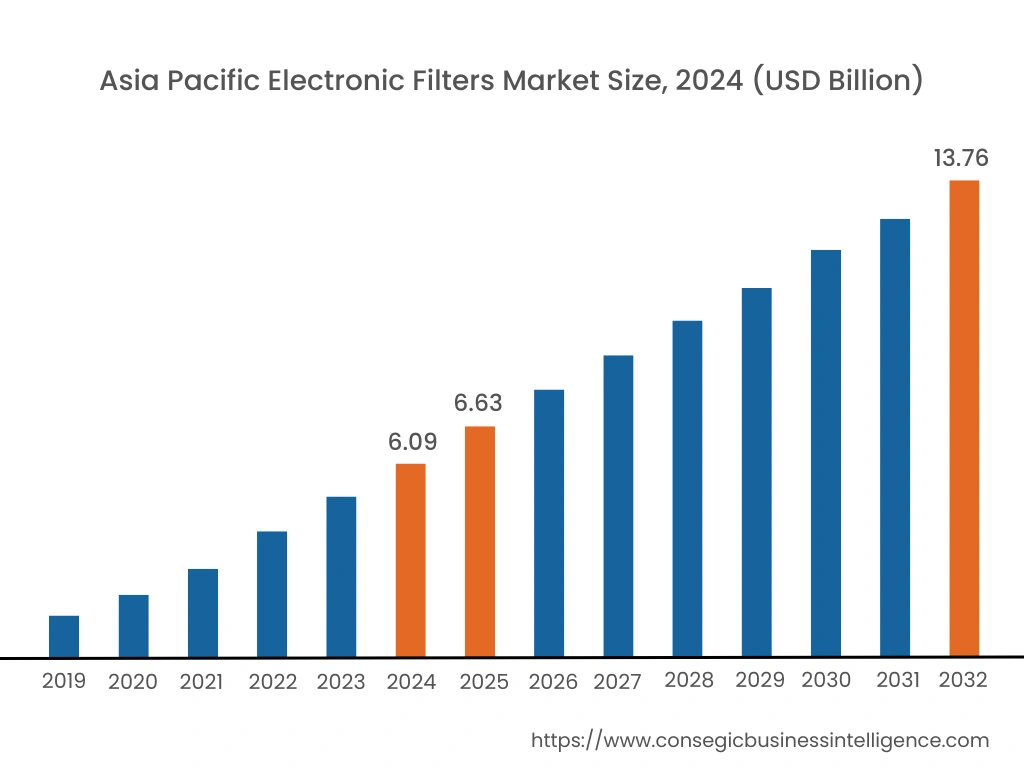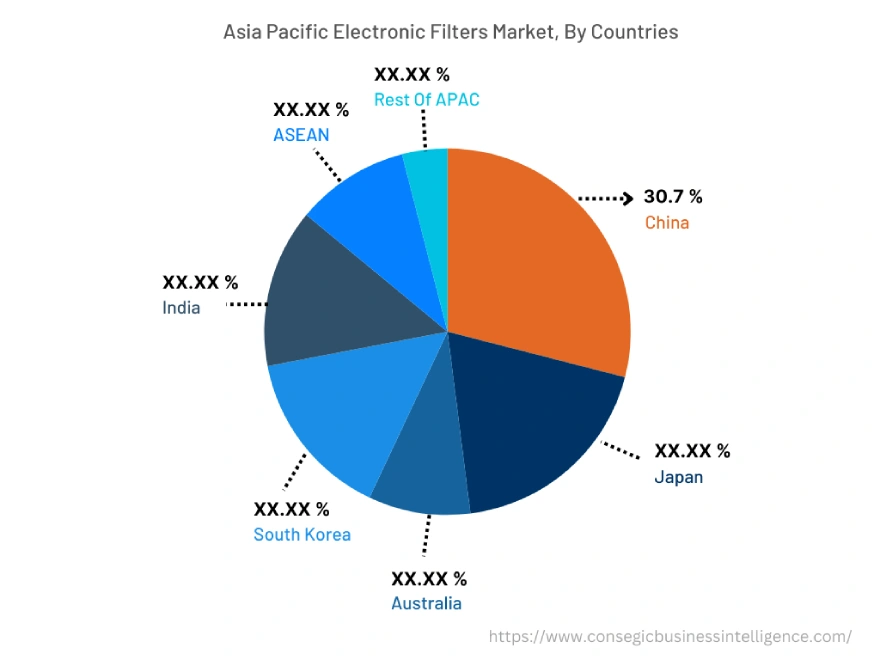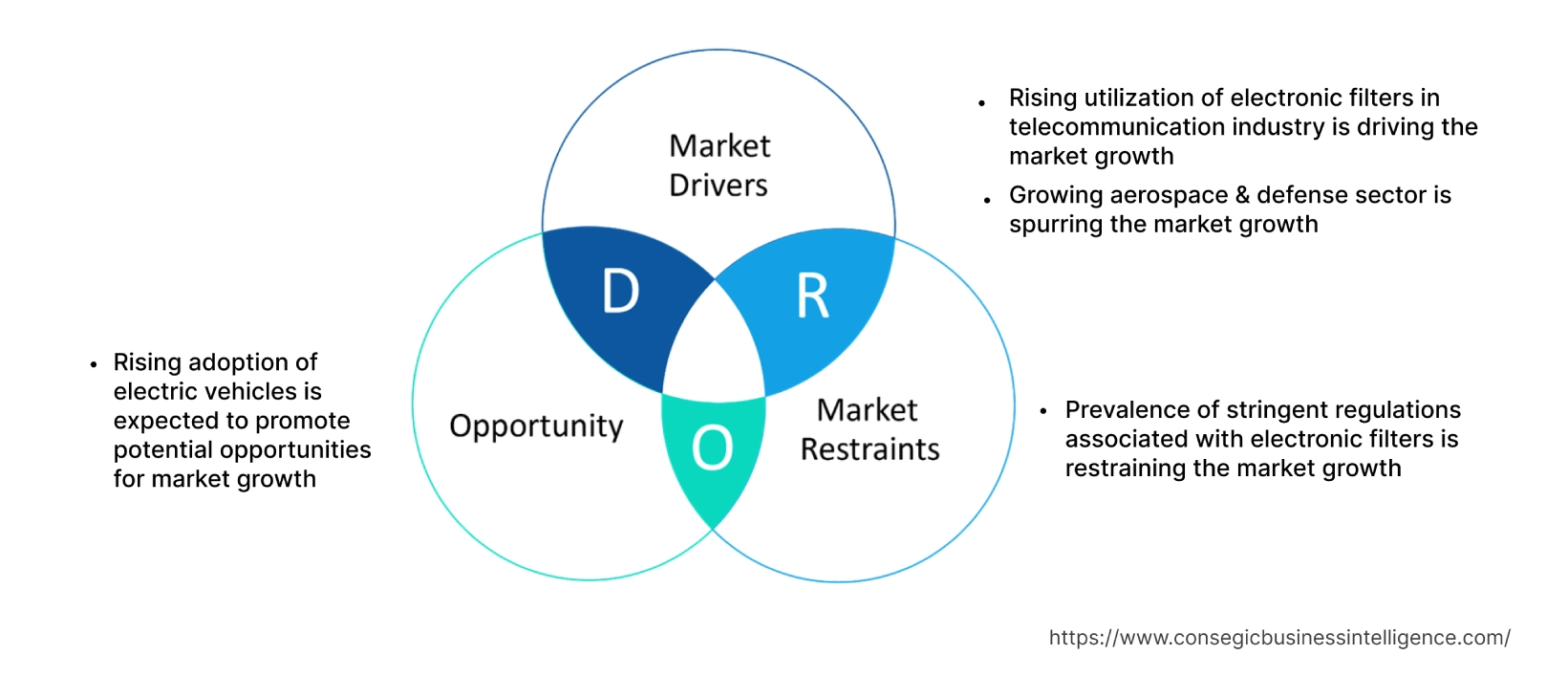- Summary
- Table Of Content
- Methodology
Electronic Filters Market Size :
Electronic Filters Market size is estimated to reach over USD 45.2 Million by 2032 from a value of USD 20.69 Million in 2024 and is projected to grow by USD 22.45 Million in 2025, growing at a CAGR of 10.30% from 2025 to 2032.
Electronic Filters Market Scope & Overview:
Electronic filters refer to a type of signal processing filter that is available in the form of electrical circuits. Electronic filters are designed for removing, attenuating, or altering the characteristics of electrical signals. Moreover, electronic filters are also capable of reducing the phase and magnitude of unwanted signals with certain frequencies while enhancing the desired signals. The aforementioned characteristics of electronic filters are key determinants for increasing the utilization in consumer electronics, automotive, telecommunication, and other industries.
Electronic Filters Market Insights :
Key Drivers :
Rising utilization of electronic filters in telecommunication industry is driving the market growth
Electronic filters are primarily used in the telecommunication industry, particularly for applications including power supplies and communication systems for selecting or passing desired signals and rejecting or blocking undesired signals. Moreover, electronic filters are used for eliminating undesired high frequencies and noise that are present on AC input lines to block the noise from entering and disrupting the operation of the telecommunication equipment.
Factors including the increasing deployment of 5G infrastructure and growing demand for high speed communication and cloud-based services are among the key prospects driving the growth of telecommunication industry.
For instance, Telefonica deployed its 5G services to nearly 1,400 municipalities in Spain in 2022, with the target of reaching 2,400 municipalities by the end of 2023, demonstrating an incline of 71.4%. Hence, the expansion of 5G infrastructure and growth of telecommunication industry are increasing the adoption of electronic filters for the utilization in 5G base stations and advanced communication systems, in turn driving the electronic filters market trends.
Growing aerospace & defense sector is spurring the market growth
Electronic filter is an essential safety and efficiency tool for aircraft power supplies and electronic systems. Electronic filters are used in the aerospace & defense sector for protecting sensitive equipment from power spikes and surges, filtering out unwanted harmonics, and reducing electromagnetic interference (EMI).
Factors including increasing aircraft production, growing commercial flight activities, and rising investments in air defense systems are key aspects driving the growth of the aerospace & defense sector.
For instance, in December 2022, Dassault Aviation launched its Rafale fighter aircraft for utilization in Directorate General of Armaments, a France-based military procurement agency. Further, Airbus delivered 661 commercial aircraft in 2022, witnessing a growth of 8% as compared to 611 deliveries in 2021.
Thus, the growing aviation and defense sector is driving the utilization of electronic filters for application in aircraft power electronic systems including displays, communication and navigation electronics, and others. The above factors are further proliferating the growth of the market.
Key Restraints :
Prevalence of stringent regulations associated with electronic filters is restraining the market growth
The manufacturers of electronic filter have to compulsorily comply with various stringent standards such as Restrictions of Hazardous Substances (RoHS), International Organization for Standardization (ISO: 31.160), MIL-STD (Military Standard), and others, which is a prime factor restricting the market growth.
For instance, ISO: 31.160 standard is applicable to electrical and electronic filters and ensures that an organization has developed, maintains, and continuously improves the business processes with respect to appropriate quality standards.
Further, electronic filters designed for aerospace & defense applications must comply with MIL-PRF-15733 and MIL-PRF-28861 standards. Therefore, the prevalence of the aforementioned regulations and standards associated with electronic filters are restraining the growth of the market.
Future Opportunities :
Rising adoption of electric vehicles is expected to promote potential opportunities for market growth
The rising adoption of electric vehicles is expected to present potential opportunities for the growth of the electronic filters market. Electronic filters are often used for elimination of undesired high frequencies and noise in electric vehicle's power supplies that are further used for powering multiple EV components including inverters, motors, converters, and others. Moreover, the utilization of electronic filters in electric vehicles ensures the provision of a reliable power source for in-car entertainment system and battery management system along with other EV components including radio, and other ancillary equipment in electric vehicles.
Factors including the progressions in electro mobility, availability of a broad range of models, eco-friendliness, and accessibility to subsidies and tax rebates are driving the adoption of electric vehicles.
According to the International Energy Agency (IEA), the global sales of electric cars observed a significant growth in 2022. According to IEA, the global sales of electric vehicles reached up to 2 million units during the first quarter of 2022, representing an incline of 75% in comparison to the first quarter of 2021.
Hence, the rising adoption of electric vehicles is anticipated to increase the utilization of electronic filters for application in EV power supply and electronic systems, in turn promoting opportunities for market growth during the forecast period.
Electronic Filters Market Report Insights :
| Report Attributes | Report Details |
| Study Timeline | 2019-2032 |
| Market Size in 2031 | USD 45.2 Billion |
| CAGR (2025-2032) | 10.3% |
| By Type | High Pass Filter, Low Pass Filter, Band Pass Filter, Band Reject Filter, and Others |
| By Application | Power Supplies, Audio Electronics, Communication System, and Others |
| By End-User | Consumer Electronics, Automotive, Telecommunication, Aerospace & Defense, and Others |
| By Region | North America, Europe, Asia-Pacific, Latin America, and Middle East & Africa |
| Key Players | STMicroelectronics, Analog Devices Inc., KYOCERA AVX Components Corporation, BLOCK Transformatoren-Elektronik GmbH, Captor Corporation, Cosel Europe GmbH, Mini-Circuits, Microwave Filter Company Inc., Anritsu Corporation, EMI Solutions, Anatech Electronics Inc. |
| Geographies Covered | |
| North America | U.S. Canada Mexico |
| Europe | U.K. Germany France Spain Italy Russia Benelux Rest of Europe |
| APAC | China South Korea Japan India Australia ASEAN Rest of Asia-Pacific |
| Middle East and Africa | GCC Turkey South Africa Rest of MEA |
| LATAM | Brazil Argentina Chile Rest of LATAM |
| Report Coverage | Revenue Forecast, Competitive Landscape, Growth Factors, Restraint or Challenges, Opportunities, Environment & Regulatory Landscape, PESTLE Analysis, PORTER Analysis, Key Technology Landscape, Value Chain Analysis, Cost Analysis, and Regional Trends & Forecast |
Electronic Filters Market Segmental Analysis :
By Type :
Based on the type, the market is bifurcated into high pass filter, low pass filter, band pass filter, band reject filter, and others. The low pass filter segment accounted for the largest revenue share of 37.39% in the year 2024. Low pass filter refers to a type of electronic filter that are capable of passing signals with a frequency lower than a selected cut-off frequency while attenuating signals with frequencies higher than the cut-off frequency. Moreover, low pass filters offer several benefits including smoother form of signal, removal of short-term fluctuations and removal of aliasing effect among others. Additionally, low pass filters are deployed in various applications including audio electronics, power supplies, communication systems, and others.
For instance, STMicroelectronics offers MLPF-WB-01D3 model of low pass filters in its product portfolio. The low pass filter offers several features including low insertion loss, small footprint, and high RF performance. Thus, the rising advancements associated with low pass filters are among the prime factors driving the growth of the market.
The high pass filter segment is anticipated to register the fastest CAGR growth during the forecast period. High pass filter refers to an electronic filter that is designed for passing signals with a frequency higher than a certain cut-off frequency and attenuating signals with frequency range lower than the cut-off frequency. Moreover, high pass filters are capable of efficiently eliminating noise and improving signal quality. The above characteristics of high pass filters are increasing the utilization in consumer electronics, automotive, and telecommunication industries among others.
For instance, KYOCERA AVX Components Corporation offers a range of multilayer organic high pass filters in its product portfolio. The high pass filters feature high frequency range and low insertion loss and are designed for application in telecommunication, consumer electronics, and other industries. Thus, the rising development of high pass filters for telecommunication and other industrial applications is anticipated to boost the growth of the market during the forecast period.

By Application :
Based on the application, the market is segregated into power supplies, audio electronics, communication system, and others. The communication system segment accounted for the largest revenue share in the year 2024. Electronic filters are commonly used in communication systems for removal of unwanted frequency components from the applied signal, while enhancing the desired signals. Moreover, the ability of electronic filters to remove unwanted components such as noise, distortion, and interference from the input signal is a prime factor driving its application in communication systems.
For instance, according to the Department of Telecommunication of India, the overall deployment of 5G base stations reached up to 324,192 units across India as of August 2023, witnessing a significant growth of over 100% from 53,590 base stations in January 2023. Therefore, the rising development of 5G infrastructure is a prime factor driving the application of electronic filters in telecommunication systems for removal of unwanted components from signal, in turn proliferating the electronic filters market demand.
Power supplies segment is expected to witness the fastest CAGR growth during the forecast period. Electronic filters are used for eliminating undesired high frequencies and noise that are present in power supplies units including AC input lines. Electronic filters are used in power supplies for blocking the noise from entering and disrupting the operation of the electrical equipment.
In February 2023, P-DUKE Technology Co. Ltd. launched its new series of AC/DC power supply (TBF500) with up to 93% efficiency. The AC/DC power supply series are designed for high operating temperature applications and offers high reliability to various equipment including 5G communication, robotics, defense, and factory automation among others. Thus, the rising innovations associated with power supply system is anticipated to boost the growth of the segment during the forecast period.
By End-User :
Based on the end-user, the market is segregated into consumer electronics, automotive, telecommunication, aerospace & defense, and others. The telecommunication segment accounted for the largest revenue share in the year 2024. Factors including increasing deployment of 5G infrastructure and growing demand for high speed communication and cloud-based services are driving the growth of the telecommunication segment.
According to Viavi Solutions Inc., approximately 1,947 cities across the globe deployed 5G services as of January 2022, along with the addition of 635 new 5G cities in 2021. Therefore, the growth of IT & telecommunication industry is driving the adoption of electronic filters for its utilization in 5G base stations and advanced communication systems, in turn fostering the electronic filters market growth.
Aerospace & defense segment is expected to witness fastest CAGR growth during the forecast period. The growth of aerospace & defense segment is primarily driven by multiple factors including rising aircraft production, growing commercial flight activities, and increasing investments in air defense systems among others.
For instance, in September 2022, the French Government announced an investment of approximately USD 8.8 billion in the aerospace industry in the upcoming three years. The investment aims at facilitating France's autonomy in accessing space and protecting national interests in aerospace defense. Electronic filter is an essential safety and efficiency tool for aircraft power supplies and electronic systems. Thus, the growing investments in aerospace & defense sector is projected to drive the market growth during the forecast period.
By Region :
The regional segment includes North America, Europe, Asia Pacific, Middle East and Africa, and Latin America.

North America is estimated to reach over USD 14.65 Million by 2032 from a value of USD 6.86 Million in 2024 and is projected to grow by USD 7.43 Million in 2025. The market growth for electronic filters in the North American region is primarily driven by its utilization in telecommunication, automotive, aerospace & defense, and other industries. Moreover, the rising deployment of electronic filters in telecommunication infrastructure including base station, power supply units, and communication systems for providing improved signals are among the significant factors driving the market growth in the region.
For instance, according to the GSM Association, the overall deployment of 5G connections in North America reached approximately 140 million as of 2022. Thus, the growing telecommunication industry is fostering the deployment of electronic filters, in turn driving market growth in the North American region. Further, factors including the increasing investment in the field of electric vehicles and air defense systems are projected to drive the market growth in North America during the forecast period.
Asia-Pacific is expected to grow with the highest CAGR growth of 10.70% and is estimated to reach over USD 13.76 Billion by 2032 from a value of USD 6.09 Billion in 2024 and is projected to grow by USD 6.63 Billion in 2025. In addition, in the region, the China accounted for the maximum electronic filters market share of 30.7% in the same year.
The increasing pace of industrialization and development is providing lucrative growth prospects for the market in the region. Further, factors including the growth of various industries including automotive, consumer electronics, telecommunication, and others are driving the market growth for electronic filters in the Asia-Pacific region.
For instance, according to the International Organization of Motor Vehicle Manufacturers, the total volume of automotive production across the Asia-Pacific region reached 50.02 million in 2022, demonstrating an increase of 7% in contrast to 46.76 million in 2021. Thus, the growing automotive sector in the Asia-Pacific region is driving the utilization of electronic filters to ensure the provision of a reliable power source for in-car entertainment system and battery management system along with other automobile electronic components. The above factors are expected to boost market growth in the region during the forecast period.

Top Key Players & Market Share Insights:
The electronic filters market is highly competitive with major players providing electronic filters to the national and international markets. Key players are adopting several strategies in research and development (R&D), product innovation, and end-user launches to hold a strong position in electronic filters market. Key players in the electronic filters market include-
- STMicroelectronics
- Analog Devices Inc.
- Microwave Filter Company Inc.
- Anritsu Corporation
- EMI Solutions
- Anatech Electronics Inc.
- KYOCERA AVX Components Corporation
- BLOCK Transformatoren-Elektronik GmbH
- Captor Corporation
- Cosel Europe GmbH
- Mini-Circuits
Recent Industry Developments :
- In April 2019, K.S. Instruments Pvt Ltd acquired EMI Solutions Pvt. Ltd, an Indian manufacturer of EMI/RFI filter. The acquisition aims at expanding the company's product portfolio.
Key Questions Answered in the Report
What is electronic filters? +
Electronic filters refers to a type of signal processing filter that are available in the form of electrical circuits. Electronic filters are designed for removing, attenuating, or altering the characteristics of electrical signals.
What specific segmentation details are covered in the electronic filters report, and how is the dominating segment impacting the market growth? +
For instance, by type segment has witnessed low pass filter as the dominating segment in the year 2024, owing to the increasing adoption of low pass filters in various applications including audio electronics, power supplies, communication systems, and others.
What specific segmentation details are covered in the electronic filters market report, and how is the fastest segment anticipated to impact the market growth? +
For instance, by end-user segment has witnessed aerospace & defence as the fastest-growing segment during the forecast period due to rising adoption of electronic filters in aircraft power supplies and electronic systems.
Which region/country is anticipated to witness the highest CAGR during the forecast period, 2025-2032? +
Asia-Pacific is anticipated to register fastest CAGR growth during the forecast period due to rapid pace of industrialization and growth of multiple industries such as automotive, consumer electronics, telecommunication, and others.


